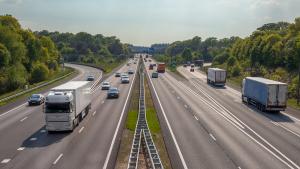
The global transport sector has the highest reliance on fossil fuels of any sector. In 2021 it accounted for almost one fourth of global greenhouse gas (GHG) emissions. The road transport sector, including passenger cars, buses, heavy and light duty commercial vehicles, is the major GHG contributor of the transport sector, accounting for approximately 77% of global transport related GHG emissions.
Sustainable low carbon mobility is thus a high policy priority for practically all Governments and central to delivering on Sustainable Development Goals and the Paris Agreement. However, the road to achieving this remains a cumbersome one.
This was at the centre of debates at the event organized today at COP28’s SDG Pavilion by UNECE, UNESCAP and UN DESA.
To get on track with the Net Zero Emissions (NZE) by 2050 Scenario, CO2 emissions from the transport sector must fall by more than 3% per year to 2030. Today`s combustion engine dominated transport sector continues to rely on oil products for nearly 91% of its final energy.
The drastic reductions in emissions and guaranteed high transport accessibility levels that are needed can only be achieved through a mix of policies and measures, involving:
-
Strong regulations (to discourage high emitting operations) and fiscal incentives (to help boost the lower emitting ones);
-
Investment in infrastructure to enable low- and zero-emission vehicle operations;
-
A real push towards modal shift from road towards less emitting rail and inland waterways and away from passenger vehicle-based mobility towards active mobility and public transport;
-
Enhanced cross-sectoral cooperation.
“As the world faces a projected increase of 79% in transport passenger demand and 100% in freight demand by 2050, the road-based transport sector bears a unique and urgent responsibility in helping countries meet their climate change mitigation goals and decarbonize,” noted UNECE Executive Secretary Tatiana Molcean.
Reducing emissions from transport implies a rapid shift from fossil energy to low-carbon sources of energy, which will have a significant impact on global energy demand and supply chains. With record sales of electric cars in 2022 and their expected continued growth, the electrification of vehicles is an important tool to align the transport sector with a climate neutral future and achievement of the Sustainable Development Goals (SDGs).
Focused on climate actions, UNECE’s Inland Transport Committee (ITC) agreed on dedicated actions to facilitate wider adoption of electric vehicles (EVs) by working on policy harmonization, improving relevant data collection, and fostering global exchanges among experts in the public and private sector.
In addition, ITC is developing an ambitious, long-term strategy and action plan for reducing GHG emissions from the transport sector by 2050, that will be presented at its next session in February 2024.
Transport-energy nexus
Many solutions to address climate change and decarbonize the inland transport sector sit at the nexus of transport and energy. Transport needs energy to move people and goods, and energy needs transport to be delivered where it is consumed.
The decarbonization of transport should go hand in hand with the integrated planning of transition in the energy sector.
Investments in the grid are fundamental to support the electrification of transport and the integration of renewable electricity. Electric vehicles can play a role to support temporary storage of renewable electricity with the wide deployment of bi-directional charging, together with the appropriate technical and fiscal policies. Another dimension in the transition to low carbon mobility and renewable energy sources is the need to ensure access, availability and affordability of critical raw minerals for all.
To align policies and overcome shared challenges, it is essential not only to foster strong cooperation between the energy and transport sectors, but also to build partnerships across the United Nations system, regional organizations, international financial institutions, private sector, and academia.
UNECE tools facilitate the transition
As the global United Nations platform for inland transport, the UNECE Inland Transport Committee (ITC) administers 60 legal instruments essential to the development of efficient, harmonized, and integrated, environmentally sound, safe, and sustainable inland transport systems. No less than 152 UN member States (many from outside the UNECE region) are contracting parties to at least one of the inland transport legal instruments, underlining their global relevance and impact.
ITC’s long-term strategy and action plan aims to help define how ITC can better assist its member States and Contracting Parties to make the most of UN legal instruments to achieve the goal of net zero GHG emissions from inland transport by 2050.
Under the purview of ITC, UN regulations already enable harmonized measurement of vehicles fuel consumption and tailpipe CO2 emissions and the widespread introduction of alternative fuel sources, including electric, hybrid and hydrogen.
In addition, UNECE is developing a globally harmonized methodology to determine vehicles’ carbon footprint throughout their life cycle, and is working to regulate the climate impact of some 23 million used vehicles, which were exported in 2015-2020, around 66% of which to developing and transitional countries.

